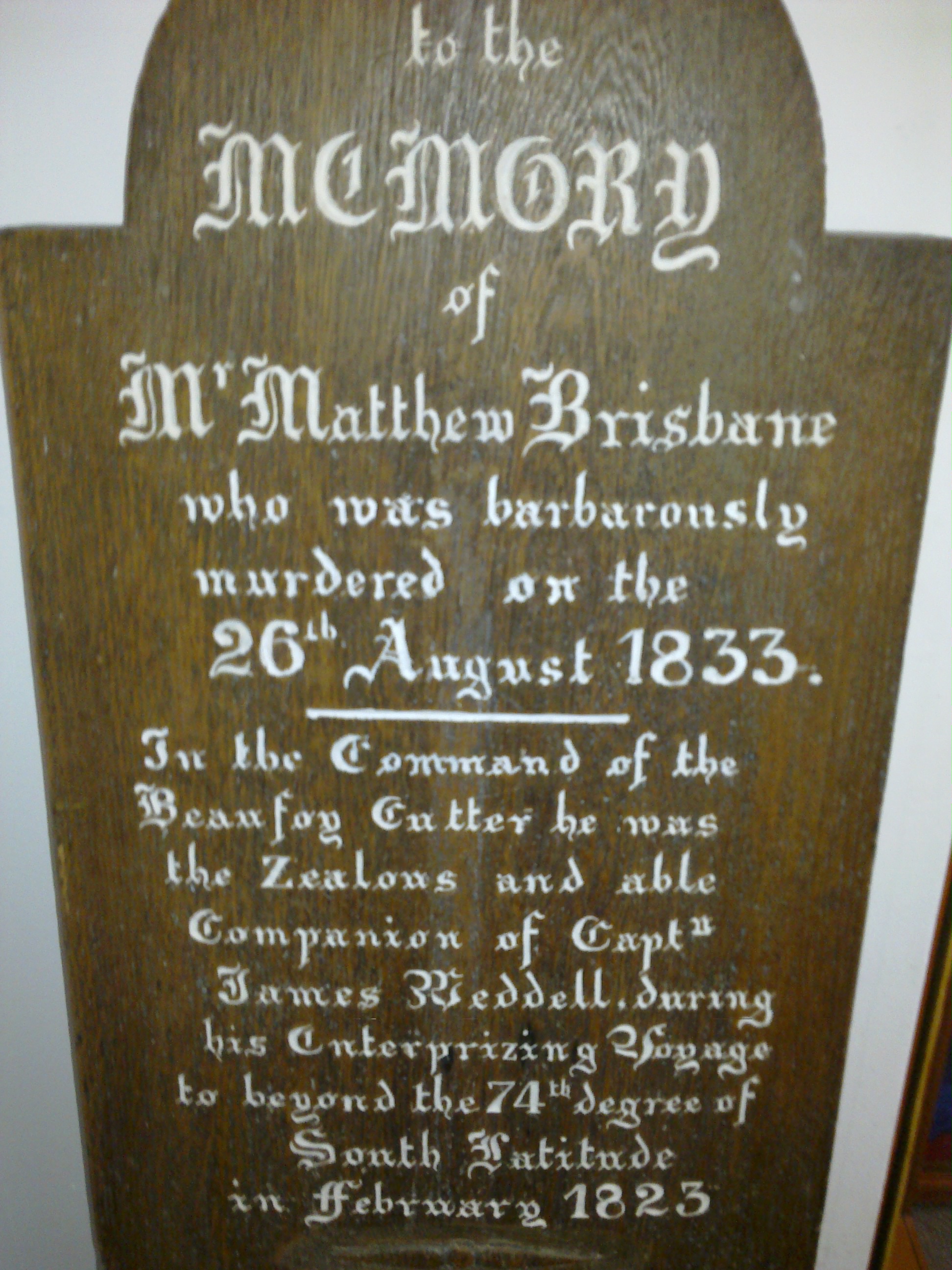Bruce Gittings, Vice Chair of the Perth-based Royal Scottish
Geographical Society remembers Matthew Brisbane, a little-known Perth-born
explorer who was influential in the Falkland Islands in
the early 1830s. This was a time when Britain
was re-asserting its claim over Argentina
- or the newly-independent United Provinces of Río de la Plata, which later became
part of the Argentine
Republic.
Matthew Brisbane was born in Perth in 1797, the son of a blacksmith who
lies buried in an unmarked grave in Greyfriars Kirkyard. Little is known of his early life, but he went
on to accompany explorer James Weddell to the Southern Ocean. Brisbane captained the cutter Beaufoy while Weddell sailed the Jane looking for seals while also
engaged in exploration.
 |
| Painting of James Weddell´s second expedition, depicting the brig "Jane"
and the cutter "Beaufroy", published in James Weddell´s book, first
edition, London, 1825 (public domain) |
Brisbane reached
Patagonia and the pair surveyed the then recently discovered South
Orkney Islands in 1823. They sailed south once more and, on 20th
February 1823, reached 74° 15' S - a record extremity for the time - within
what is now the Weddell Sea, close to the coast of Antarctica.
Brisbane
returned to Britain in 1826,
but soon set sail again, this time commanding the Prince of Saxe-Coburg and intent on capturing seals in the South Orkney Islands. However, he was shipwrecked off Tierra del Fuego and rescued after some months by HMS Beagle. He had an unlucky time on
the seas and was shipwrecked twice more in 1829: in the Hope off South Georgia and in the Bellville again off Tierra del Fuego.
Brisbane then
settled in the Falkland Islands, becoming Superintendent of Fisheries for the
German-Argentinian merchant Luis Vernet (1791 - 1871) who had been appointed
Governor of the islands by Argentina.
Brisbane was
at the centre of conflicting interests as Britain
re-asserted its authority over the islands following twelve years of rule by Argentina.
The British first landed on the Falklands in 1690, naming them after a Scottish nobleman,
but left in 1776 due to pressures on military expenditure because of the
American War of Independence. They did
however make clear that sovereignty was not being renounced.
The Falklands at this
time was a lawless place, with sealers, fishermen, adventurers and the
beginnings of a penal colony. As an
official of the islands Brisbane presented
himself to Captain Fitzroy on HMS Beagle when
it called at the Falklands in 1833, this time
with Charles Darwin on board.
However, Brisbane,
alongside a number of island officials, was murdered by a group of Argentinian
gauchos and convicts the later same year, following a disagreement over
payments, and was hastily buried. The
exact circumstances were not clear at the time and his brother, John Brisbane,
living at 17 John Street
in Perth asked
the Admiralty to investigate.
Thomas Helsby,
a British clerk, was a witness to the murders and his account of meeting the
killers was recorded “I was ordered by them into Captain Brisbane's house, and
there first saw his body lying dead upon the floor, he appeared to have been
making towards his pistols before he fell, and there was smile of contempt or
disdain very strongly marked in his countenance. They dragged his body with a
horse to a considerable distance, and plundered the house.”
 The Beagle’s Captain Fitzroy returned to the
island and was disgusted to find Brisbane
in a shallow grave, his feet protruding from the ground. He wrote: “This was the fate of an honest,
industrious, and most faithful man: of a man who feared no danger, and despised
hardships. He was murdered by villains, because he defended the property of his
friend; he was mangled by them to satisfy their hellish spite; dragged by a
lasso, at a horse's heels, away from the houses, and left to be eaten by dogs.”
In 1842, Brisbane’s remains
were moved to a nearby graveyard on East Falkland
and a marker erected by the noted Scottish explorer James Clark Ross (1800-62).
The Beagle’s Captain Fitzroy returned to the
island and was disgusted to find Brisbane
in a shallow grave, his feet protruding from the ground. He wrote: “This was the fate of an honest,
industrious, and most faithful man: of a man who feared no danger, and despised
hardships. He was murdered by villains, because he defended the property of his
friend; he was mangled by them to satisfy their hellish spite; dragged by a
lasso, at a horse's heels, away from the houses, and left to be eaten by dogs.”
In 1842, Brisbane’s remains
were moved to a nearby graveyard on East Falkland
and a marker erected by the noted Scottish explorer James Clark Ross (1800-62).
Brisbane’s
name is commemorated in Brisbane
Road in Stanley
(Falkland Islands), Cape Brisbane on Henderson
Island (Tierra del Fuego) and Brisbane Heights
on Coronation Island
(South Orkney Islands).
Bruce
Gittings’ interest in the subject stems from his work on the Gazetteer for
Scotland, an authoritative web site which attempts to catalogue the bens and
glens of Scotland, together with the people who inhabited them. This work has been ongoing since 1995 and now
represents a massive body of information.
The
Royal Scottish Geographical Society celebrates exploration through its
collections and education work, and the Society’s visitor centre in The Fair Maid’s House, Perth.
www.rsgs.org










